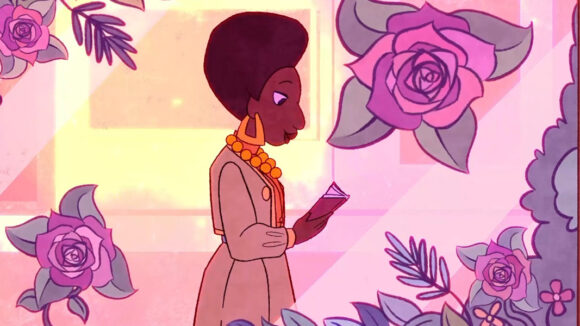

2025 Oscars Short Film Contenders: ‘Nate & John’ Director Jumai Yusuf
Cartoon Brew is putting the spotlight on animated short films that have qualified for the 2025 Oscars.
In this installment, we’re looking at Nate & John from Nigerian-American director Jumai Yusuf. The short earned its Oscars qualification through theatrical exhibition.
Nate & John tells the story of a blossoming friendship between a client and a barber, unfolding through time while they both navigate the ups and downs of life. With her short, Jumai Yusuf traveled to Cannes this year, where the film won the cultural impact award at the American Pavilion, as part of the emerging filmmakers’ showcase.
Cartoon Brew: Music plays an important role in your film, settling the mood for a lasting friendship punctuated by the obstacles and challenges of life. How did you work with composer Pedro Osuna to achieve this and what were your inspirations in this process?

Jumai Yusuf: With no dialogue in the film, music was always essential to my approach. I couldn’t have asked for a better collaborator than composer Pedro Osuna, who took my abstract ideas and crafted a phenomenal score that brings the characters’ emotional journeys to life and carries the storytelling forward. The music fills the space where dialogue would be, making you feel like nothing is missing. We instantly agreed on a jazz score, and one of our key inspirations was the anime Kids on the Slope. Jazz perfectly captures the energy of the barbershop — the art of cutting hair is naturally rhythmic and full of life — and I wanted the music and sound design to reflect that. Our sound team, designer Saranya Nayak and mixer Ajeng Canyarasmi, achieved this brilliantly, even while working from different countries. I love how these elements build and weave together seamlessly, enhancing the experience as a unified whole.
What was it about this story or concept that connected with you and compelled you to direct the film?
Nate & John tells the story of a lifelong friendship, set within the familiar walls of a barbershop. To me, barbershops and salons are unique, almost magical places, where people feel safe enough to lower their barriers. They are one of the last spaces in modern society that nurtures face-to-face connections, allowing people to bond on a basic human level.
I instantly connected with John’s relationship with his lifelong barber, Nate, as I’ve been going to the same hairdresser since I was a teenager. Even after moving across the country to Los Angeles, I still make it a point to visit her salon whenever I’m visiting my family back home. This is one of the longest relationships I’ve had in my life, and through directing this film, I wanted to honor the special role hair professionals play in our lives. At its heart, Nate & John is the kind of story I believe the world needs now. A story of healthy male friendship between two people who, on the surface, couldn’t be more different. It’s a reminder that we’re more alike than we are different, and that just one person can have a profound impact on an entire community.
What did you learn through the experience of making this film, either production-wise, filmmaking-wise, creatively, or about the subject matter?
The journey of making this film taught me everything I know about 2d animation! I come from a live-action filmmaking background, but during the pandemic, I began teaching myself animation using Unreal Engine. So while I had a bit of experience with 3d animation, Nate & John marks my first time directing a 2d animated short.
When the script came to me, I reached out to fellow USC alums, producer Jean Liu and storyboard artist Dariel Filomeno, and together we decided to take on the challenge of making an animated short independently, outside the structure of a school. We established a production pipeline on Discord, collaborating remotely with artists from around the world during the pandemic. I would love to continue making animated films with the incredible artists I met and to build on the knowledge I gained throughout this process.
Can you describe how you developed your visual approach to the film? Why did you settle on this style/technique?
I love the texture and warmth that hand-drawn 2d animation brings, so choosing this medium was a no-brainer. Early on, I shared a variety of inspirations with our artists, including artwork from the video game Gris, character designs and concept art from Spider-Man: Into the Spider-Verse, and beautiful illustrations I discovered while scouring the internet. I worked with our color designer, Kageri Kindongo, to craft a color palette that reflects each decade as Nate and John’s lives unfold. Our visual development team had a great time designing period-specific hairstyles, fashions, and interior designs to capture the essence of each era. The final look came together in compositing, where our team experimented with effects and texturing techniques to create the final, expressive visual style.

.png)